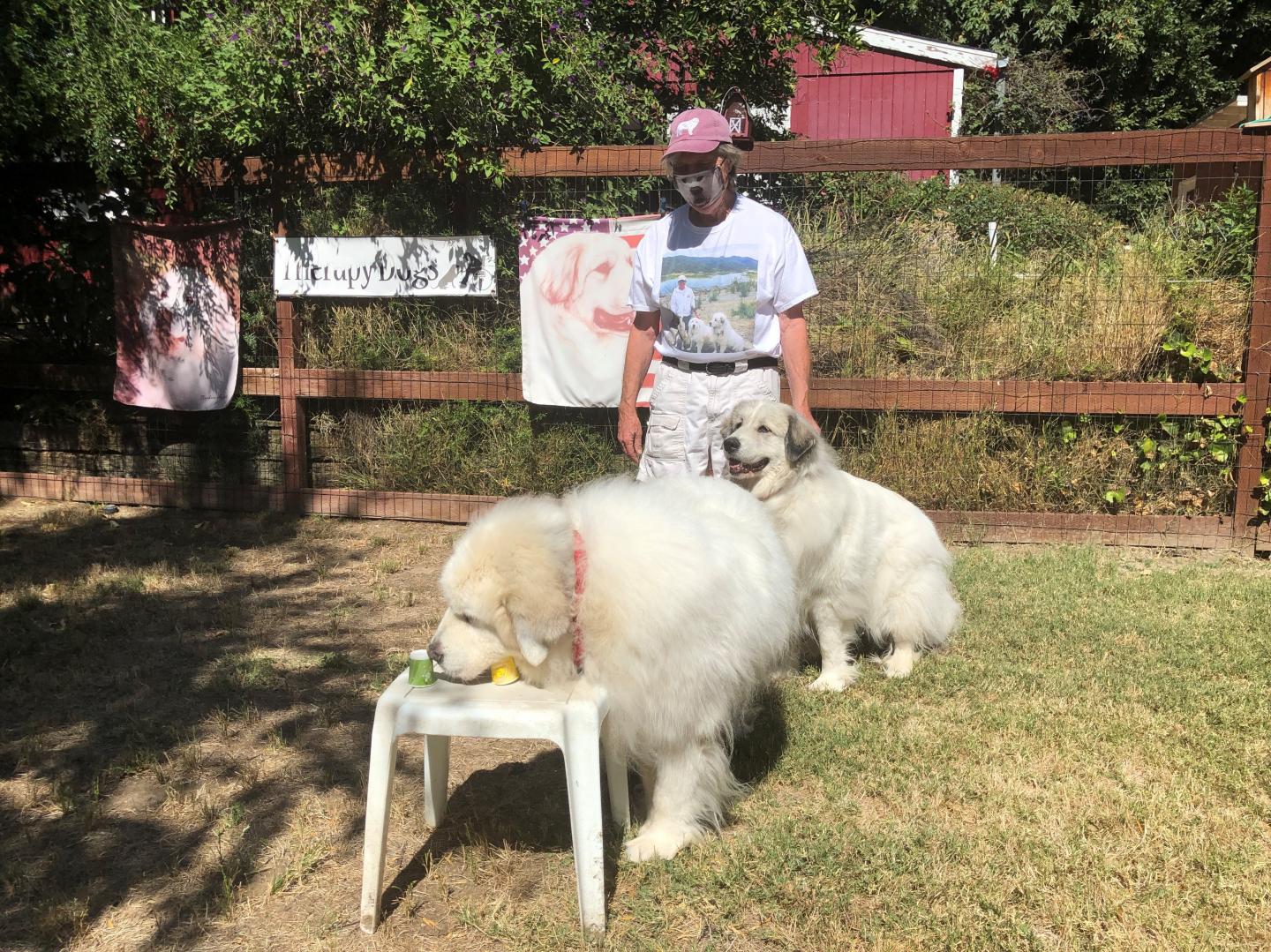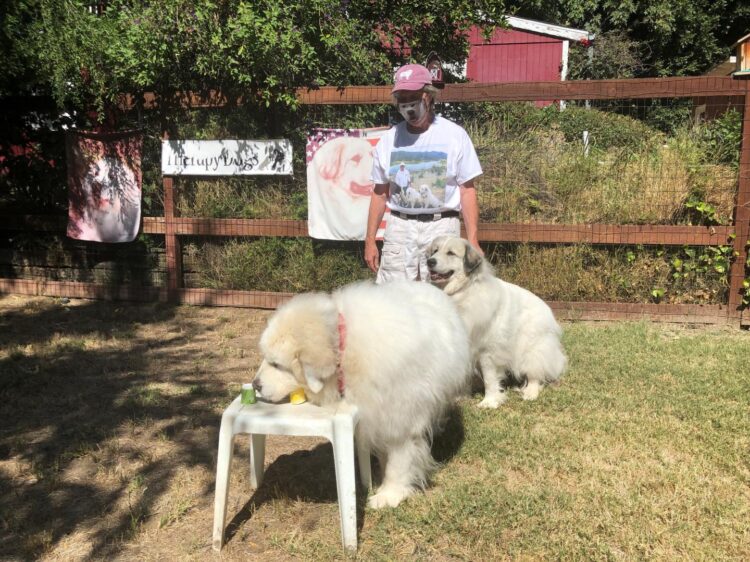The use of trained scent detection dogs to detect volatile organic compounds associated with the COVID virus shows promise in early studies

Credit: Tommy Dickey, PhD
In a recent article in the Journal of Osteopathic Medicine, authors gathered previously published research to summarize current thinking on the feasibility and efficacy of using scent detection dogs to screen for the COVID-19 virus. The researchers report that sensitivity, specificity, and overall success rates reported by the canine scent detection studies are comparable or better than the standard RT-PCR and antigen testing procedures.
These findings indicate scent detection dogs can likely be used to effectively screen and identify individuals infected with the COVID-19 virus in hospitals, senior care facilities, schools, universities, airports, and even large public gatherings for sporting events and concerts.
“Accurate and rapid screening of individuals who may be carriers, symptomatic or asymptotic, of the COVID-19 virus will remain important for slowing and limiting the spread of infection,” said Tommy Dickey, PhD, professor, University of California, Santa Barbara. “These preliminary studies suggest the use of medical scent detection dogs offers a promising approach.”
Documented success detecting disease
Dogs can sense a broad range of molecules with extremely small concentrations: 1 part in a quadrillion compared with 1 part in 1 billion for humans. This capability is used for search and for identification of diseases with their individual chemistries and odors.
Using inhaled air molecules and particulates, dogs can detect odorous human molecules (volatile organic compounds, or VOCs) that originate from flaked off skin or hair cells, blood, breath, saliva, sweat, tears, nasal mucous, urine, semen, or feces. Since smells linger, dogs can maintain a historical library of the smells of complex molecules.
“The science behind and efficacy of using dogs in detecting medical conditions and diseases such as cancers, diabetes, malaria, Parkinson’s disease, and more has been documented,” said Heather Junqueira. “These new studies provide support for additional research to determine their ability to detect COVID-19 at scale.”
The qualified studies
For their review, the authors assessed four recent studies analyzing the success of scent detecting dogs at identifying VOCs associated with COVID-19. First, they described the work of a team of collaborating researchers from France and Lebanon, who tested with 8 dogs that had previously been trained to detect both explosives and colon cancer.
These dogs were independently presented with cotton or wool gauze samples that had been soaked with sweat from one of 198 human armpits of patients in different hospitals. While the COVID-19 virus does not itself have a smell, researchers hypothesized that the resulting infection generates metabolic changes, which cause the release of a distinctive type of sweat odor that can be detected by a dog.
The dogs were trained to only sit in front of a COVID-19-positive sample contained in a box with a sample canister. After four days of training using COVID-19 samples, the success rate for the dogs ranged between 83 and 100%.
Saliva or tracheobronchial secretions
In another study described by the authors, a research team in Germany conducted a randomized, double-blinded, controlled pilot study to determine whether previously trained scent dogs could successfully detect the presence of the COVID-19 virus. Dogs were trained over 1 week to detect the COVID-19 virus in samples of saliva or tracheobronchial secretions collected from infected patients.
Each dog, its handler, and the person observing the study were blindfolded. The number and duration of each dogs’ “nose dips” into the scent holes, along with the location of the positive and negative samples, were automatically recorded and verified using time-stamped video analysis, which automated the process and reduced trainer interference.
The results, derived from 1,012 automated sample presentations, showed an overall average detection rate of 94%: 157 correct indications of positive, 792 correct rejections of negative, 33 false positives, and 30 false negative indications. Interestingly, the team reported no notable difference in detection ability between the use of sample saliva and sample tracheal secretion.
While that pilot study had limitations–in particular, the positive samples came only from severely affected, hospitalized COVID-19 patients and the negative samples were from healthy individuals with no indications of respiratory infections–the authors of the present study found those results encouraging.
Support for additional research
A third study done by a team in Colombia tested 6 trained scent dogs of various and mixed breeds to develop a screening method for detecting COVID-19 in individuals who may be asymptomatic, pre-symptomatic, or symptomatic.
The researchers developed a device to safely expose the scent-trained dogs to VOC samples collected from respiratory secretions of COVID-19-positive patients, and their detailed study was conducted in 3 phases, with the third phase ongoing.
“Of the 6,000 samples, the dogs’ performances [in that study] resulted in a sensitivity of 95.5% and a selectivity of 99.6%,” said Dickey. “The high success rates among different types of dogs suggests a range of breeds or mixed breeds may be trained to effectively screen for COVID-19.”
Challenges remain
“The results of recently reported and ongoing research are encouraging; however, there remain challenges to be considered before broad-scale implementation of scent detecting dogs to identify and screen for COVID-19,” said Junqueira. “Nonetheless, the research supports the use of scent detection dogs for pilot COVID-19 screening studies in venues such as airports and sporting events.”
The authors hope that their research review, which presented recent information and perspectives on the potential for broad application of trained scent dogs for screening of COVID-19-infected individuals, can be used to assist in the development of future studies and implementation of screening programs to benefit preventative medical research.
###
About the Journal of Osteopathic Medicine
The Journal of Osteopathic Medicine, founded in 1901 and known for 119 years as The Journal of the American Osteopathic Association, is the premier scholarly, peer-reviewed publication of the osteopathic medical profession. JOM conducts peer review of academic research manuscripts from a wide variety of medical specialties, covering the full spectrum of clinical settings in which osteopathic physicians practice. All submissions are vetted by a distinguished group of Section Editors led by Editor-in-Chief Ross Zafonte, DO, and supported by a full Editorial Board.
Media Contact
Jessica Bardoulas
[email protected]
Original Source
https:/
Related Journal Article
http://dx.





